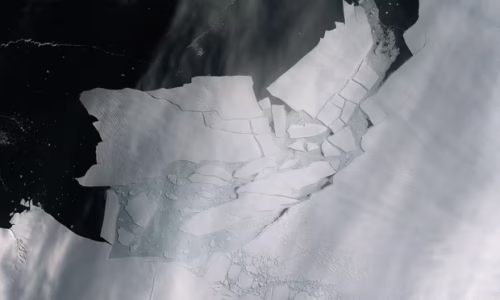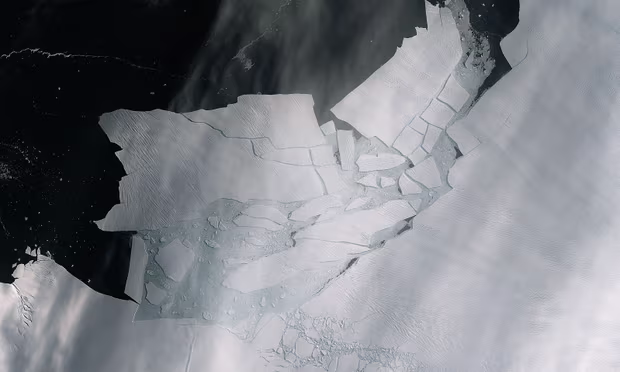Hills and valleys carved by anient rivers in area the size of Belgium has remained untouched for more than 34m years

Scientists have discovered a vast, hidden landscape of hills and valleys carved by ancient rivers that has been “frozen in time” under the Antarctic ice for millions of years.
This landscape, which is bigger than Belgium, has remained untouched for more than 34m years, but human-driven global warming could threaten to expose it, the British and American researchers warned.
But then the ice came along and it was “frozen in time”, Jamieson said.
“What is exciting is that it’s been hiding there in plain sight,” he added, emphasising that the researchers had not used new data, only a new approach.
The land underneath the east Antarctic ice sheet is less well known than the surface of Mars, Jamieson said.
The main way to “see” beneath it is for a plane flying overhead to send radio waves into the ice and analyse the echoes, a technique called radio-echo sounding.
But doing this across the continent – Antarctica is bigger than Europe – would pose a huge challenge.
So the researchers used existing satellite images of the surface to “trace out the valleys and ridges” more than 1.6 miles below, Jamieson said.
The undulating ice surface is a “ghost image” that drapes gently over these spikier features, he added.
When combined with radio-echo sounding data, an image emerged of a river-carved landscape of plunging valleys and sharply peaked hills similar to some elsewhere on the Earth’s surface.
It was like looking out the window of a long-haul flight and seeing a mountainous region below, Jamieson said, comparing the landscape with the Snowdonia in northern Wales.
Exactly when sunshine last touched this hidden world is difficult to determine, but the researchers are confident it has been at least 14m years.
Jamieson said his “hunch” is that it was last exposed more than 34m years ago, when Antarctica first froze over.
“It is an undiscovered landscape – no one’s laid eyes on it,” Prof Stewart Jamieson, a glaciologist at Durham University and the lead author of the study, said.
The area, stretching across 12,000sq miles (32,000sq km) , was once home to trees, forests and probably animals.
some of the researchers had previously found a city-size lake under the Antarctic ice, and the team believes there are other ancient landscapes down there yet to be discovered.
The authors of the study said global warming could pose a threat to their newly discovered landscape.
“We are now on course to develop atmospheric conditions similar to those that prevailed” between 14m and 34m years ago, when it was 3C to 7Cwarmer than currently, they wrote in the journal Nature Communications.
Jamieson emphasised that the landscape was hundreds of kilometres inland from the edge of the ice, so any possible exposure would be “a long way off”.
The fact that retreating ice over past warming events – such as the Pliocene period, 3m to 4.5m years ago – did not expose the landscape, was cause for hope, he added.
But it remained unclear what the tipping point would be for a “runaway reaction” of melting, he said.
The study was released a day after scientists warned that the melting of the neighbouring west Antarctic ice sheet is likely to substantially accelerate in the coming decades, even if the world meets its ambitions to limit global warming.
We know, we know, we know …
Seeing these messages is annoying. We know that. (Imagine what it’s like writing them … )
But it’s also extremely important. One of the Guardian’s greatest assets is its reader-funded model.
1. Reader funding means we can cover what we like. We’re not beholden to the political whims of a billionaire owner. No-one can tell us what not to say or what not to report.
2. Reader funding means we don’t have to chase clicks and traffic. We’re not desperately seeking your attention for its own sake: we pursue the stories that our editorial team deems important, and believe are worthy of your time.
3. Reader funding means we can keep our website open, allowing as many people as possible to read quality journalism from around the world – especially people who live in places where the free press is in peril.
At the moment, the Guardian’s work is funded by just 2.4% of our regular readers. If you’re in the other 97.6%, appreciate our work and believe that good journalism is important to protecting democracy in an age of misinformation, please consider joining the readers in Norway supporting the Guardian today.
We value whatever you can spare, but choosing an annual plan for All-access digital not only makes the most impact – enabling greater investment in our journalism – but also gives you a 17% discount compared to monthly payments. We can also offer you some great benefits (including making these messages go away.) Simply choose the annual option at checkout. We’ve made it very quick to set up, so we hope you’ll consider it. Thank you.
